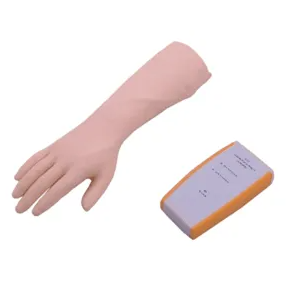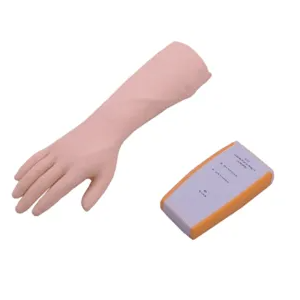
Can wrist puncture models improve the learning experience of clinical interns?
Article tag: Wrist Puncture model BIX-CK20137 Medical Clinical model

The wrist puncture model undoubtedly provides a more efficient, safe and controllable learning environment for clinical interns, significantly improving their learning experience. Through simulation training, interns can not only practice operation skills repeatedly in a risk-free environment, but also greatly strengthen the combination of theory and practice, thus improving the success rate and self-confidence of clinical operation. The experts' views and data analysis show that the simulation model plays an important role in improving the interns' technical accuracy and clinical emergency response ability, and also provides them with a bridge from theoretical knowledge to practical operation. With the continuous development of medical ed...

One of the core tasks of clinical interns in medical education is to transform theoretical knowledge into practical skills. For some high-risk, highly technical procedures, such as wrist piercings, traditional clinical training often cannot adequately meet the practice needs of interns. Wrist puncture is a procedure used to diagnose and treat joint diseases that involves detailed anatomical knowledge and precise puncture techniques. Due to the complex structure of the wrist joint and the high requirement of clinical success rate, many interns face great pressure when performing puncture operations for the first time, and may even cause discomfort or injury to patients due to unskilled technology. Whether the simulation training of wrist puncture model can improve the learning experience of clinical interns has become a question worthy of further discussion in medical education. This article will analyze the role of the wrist piercing model in enhancing the intern learning experience, combining personal growth, industry expert perspectives, professional data, and clinical practice.
The influence of model training on interns' learning experience

1. Provide a risk-free practice environment
The wrist puncture model provides a safe learning platform for clinical interns to practice puncture operations repeatedly in a risk-free environment to understand and master the correct Angle, depth and force of puncture. This "zero risk" learning model allows interns to practice repeatedly without the pressure of patients, gradually improving their operational skills and reducing the anxiety and fear caused by inproficiency. The research shows that through the simulation model training, students can get familiar with the operation process in a short time, and their confidence has been significantly improved.
2. Improve the combination of theory and practice
Many medical students learn the anatomy and puncture technique of wrist joint in class, but lack enough practice opportunities and practice places in clinical practice. Through the wrist joint puncture model, students can better combine theory with practice. The high simulation of the model enables students to operate intuitively in a simulated environment, and quickly master how to select puncture points, adjust the Angle and depth of puncture according to the actual situation of patients. This transformation from theory to practice not only deepens students' understanding of theoretical knowledge, but also improves their ability to solve clinical problems.
3. Improve operation skills and clinical confidence
Wrist puncture is a highly skilled operation, and the technical proficiency directly affects the clinical treatment effect. Using simulation models, interns can improve the technical accuracy and success rate by practicing the simulation repeatedly before operating in front of actual patients. According to a study in the Journal of Medical Education and Practice, nursing and medical students improved their success rate in clinical operations by 25 percent and their error rate by 30 percent after simulation training. The higher technical accuracy not only improves the success rate of the operation, but also enhances the self-confidence of the trainees, enabling them to cope with complex clinical scenarios.
Industry expert perspective: The potential and benefits of model training
Industry experts generally agree that the introduction of simulation models has injected new vitality into medical education, especially in improving clinical skills. Professor Zhang (an expert in the field of medical education) pointed out: "The wrist puncture model can not only help interns to practice repeatedly, but also simulate some possible complications on the model, such as bleeding and pain reactions during joint puncture. By simulating these real-world clinical challenges, interns can better prepare themselves to enter the actual clinic and avoid unnecessary mistakes caused by inexperience." This specialized training can accelerate students' transition from classroom to clinical practice, reduce trial and error in clinical practice, and enhance the overall learning experience.
Data support: The impact of simulation training on clinical interns
According to data from a survey of medical students trained using simulation models, more than 70% of interns said that simulation training greatly improved their mastery of wrist piercing techniques. Specific data show that the success rate of students trained using the simulation model when performing wrist puncture operations has increased from 60% to more than 85% of traditional training. In addition, about 78% of students said that simulation training made them more confident in clinical operations and better able to communicate with patients, reducing patient anxiety and discomfort due to unskilled operations.
conclusion
The wrist puncture model undoubtedly provides a more efficient, safe and controllable learning environment for clinical interns, significantly improving their learning experience. Through simulation training, interns can not only practice operation skills repeatedly in a risk-free environment, but also greatly strengthen the combination of theory and practice, thus improving the success rate and self-confidence of clinical operation. The experts' views and data analysis show that the simulation model plays an important role in improving the interns' technical accuracy and clinical emergency response ability, and also provides them with a bridge from theoretical knowledge to practical operation. With the continuous development of medical education, the wide application of wrist puncture models will further promote the innovation of medical training models and lay a solid foundation for students' personal growth and future clinical practice.

Marketing Center
Hong Kong, ChinaProduction Base
Shanghai, ChinaProducts
Contact Us
 Address: Hong Kong, China
Address: Hong Kong, China
 Phone:+86 19937901373
Phone:+86 19937901373
 Email:sophia@adahealthy.com
Email:sophia@adahealthy.com
 Mobile:+86-0379-65160607
Mobile:+86-0379-65160607








